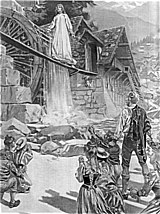About "Sleepwalker"
 La sonnambula (Italian pronunciation: [la sonˈnambula]; The Sleepwalker) is an opera semiseria in two acts, with music in the bel canto tradition by Vincenzo Bellini set to an Italian libretto by Felice Romani, based on a scenario for a ballet-pantomime written by Eugène Scribe and choreographed by Jean-Pierre Aumer called La somnambule, ou L'arrivée d'un nouveau seigneur. The ballet had premiered in Paris in September 1827 at the height of a fashion for stage works incorporating somnambulism.
La sonnambula (Italian pronunciation: [la sonˈnambula]; The Sleepwalker) is an opera semiseria in two acts, with music in the bel canto tradition by Vincenzo Bellini set to an Italian libretto by Felice Romani, based on a scenario for a ballet-pantomime written by Eugène Scribe and choreographed by Jean-Pierre Aumer called La somnambule, ou L'arrivée d'un nouveau seigneur. The ballet had premiered in Paris in September 1827 at the height of a fashion for stage works incorporating somnambulism.
The role of Amina was originally written for the soprano sfogato Giuditta Pasta and the tenor Giovanni Battista Rubini, but during Bellini's lifetime another soprano sfogato, Maria Malibran, was a notable exponent of the role. The first performance took place at the Teatro Carcano in Milan on 6 March 1831.
The majority of twentieth-century recordings have been made with a soprano cast as Amina, usually with added top-notes and other changes according to tradition, although it was released in soprano sfogato voice (not be confused with the modern mezzo, nonexistent at the time) who sang soprano and contralto roles unmodified.
The phrase Ah! non credea mirarti / Sì presto estinto, o fiore ("I did not believe I would see you fade so soon, oh flower") from Amina's final aria is inscribed on Bellini's tomb in the Catania Cathedral in Sicily.
Top songs by Bel Canto
 Dreaming Girl
Dreaming Girl Waking Will
Waking Will Bombay
Bombay Night Lady
Night Lady The Dinosauer—slipper—man
The Dinosauer—slipper—man Freelunch In The Jungle
Freelunch In The Jungle Upland
Upland Didn't You Know It?
Didn't You Know It? Sleep In Deep
Sleep In Deep Heaven
Heaven Tree
Tree Unicorn
Unicorn Foolish Ship
Foolish Ship Agnus Dei
Agnus Dei Corals, Jade And Pearls
Corals, Jade And Pearls Continuum
Continuum In Zenith
In Zenith Baltic Ice—breaker
Baltic Ice—breaker Kiss Of Spring
Kiss Of Spring Die Geschichte Einer Mutter
Die Geschichte Einer Mutter Oyster
Oyster Paradise
Paradise Idly I De—ice
Idly I De—ice Big Belly Butterflies
Big Belly Butterflies Capio
Capio Tierre Obeletz — Jacob's Lullaby (part 2)
Tierre Obeletz — Jacob's Lullaby (part 2) Birds Of Passage
Birds Of Passage Time Without End
Time Without End White—out Conditions
White—out Conditions Without You
Without You Sleepwalker
Sleepwalker Spacejunk
Spacejunk
"Sleepwalker" video by Bel Canto is property and copyright of its owners and it's embedded from Youtube.
Information about the song "Sleepwalker" is automatically taken from Wikipedia. It may happen that this information does not match with "Sleepwalker".
SONGSTUBE is against piracy and promotes safe and legal music downloading. Music on this site is for the sole use of educational reference and is the property of respective authors, artists and labels. If you like Bel Canto songs on this site, please buy them on Itunes, Amazon and other online stores. All other uses are in violation of international copyright laws. This use for educational reference, falls under the "fair use" sections of U.S. copyright law.
